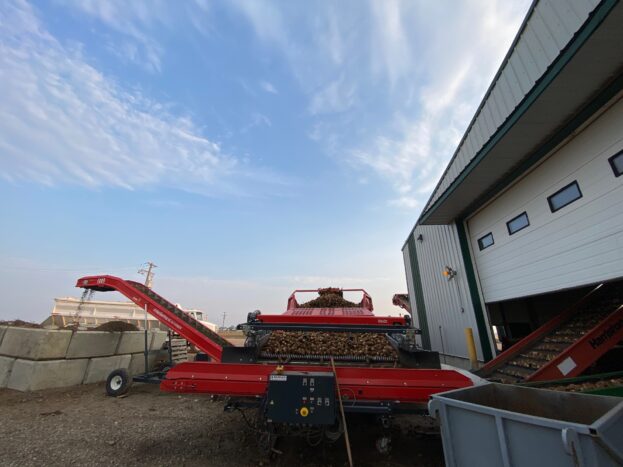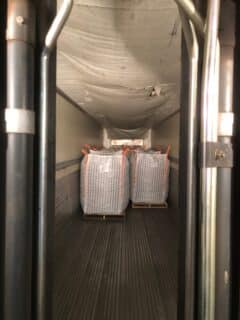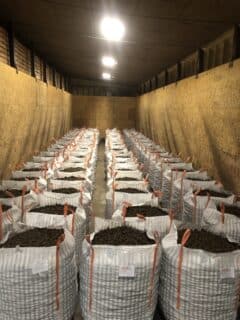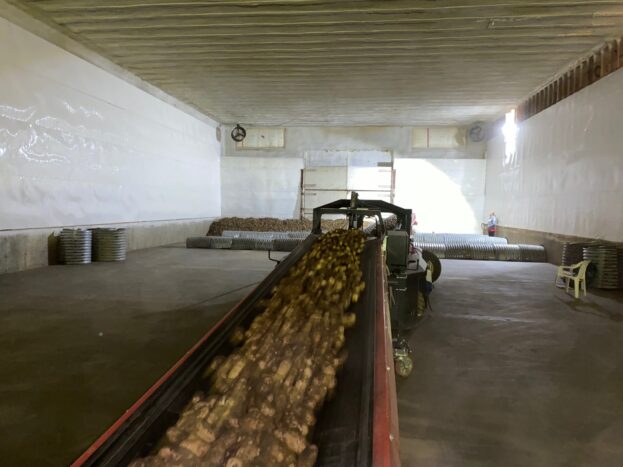Canadian potato shipping is a mismatch of shipping policies.
Anyone working in the potato shipping industry within the last few years knows it’s not always easy. Due to a plethora of reasons such as COVID-19, a trucker shortage and high inflationary prices, shipping within the last two years feels more like the Wild West than an easy endeavor.
Not only has shipping become the Wild West, but it’s not an intuitive challenge, either. Shipping processes and policies differ across the potato sector depending on whether you’re shipping seed, fresh or processing potatoes. Not only that, but whether or not it’s the grower’s responsibility also varies across Canada.
“It varies by growing region,” says Dale Lathim, executive director of the Potato Growers of Washington, in a phone interview with Spud Smart. “Here in the Columbia Basin for instance, we don’t — as growers — deliver anything to the plants. The processors pick up the potatoes at the side of our field, and they pay 100 per cent of the cost of the freight going there. However, in other regions, growers actually have to deliver directly to the plant themselves, and hopefully those freight costs should be addressed in the contracts.”

Part of the point where concern arises, Lathim says, is when regions start comparing contacts without taking differences into account.
“It can be very, very costly to haul potatoes,” he adds.
Especially as disruptions continue to add to the shipping cost, it’s important to know the costs and differences of shipping potatoes costs across North America.
Disruptions Continue to Rock the Boat
When it comes to transportation, disruptions continue to cause issues in terms of availability and cost of freight.
“Prices went way up, and there were a lot of factors there,” Victoria Stamper, general manager of United Potato Growers of Canada (UPGC), explains in a phone interview. Noting different sectors showed precursors to difficulties transporting potatoes, especially in terms of price.

In terms of transporting supply, Barry Prentice, professor of supply chain management at the University of Manitoba, describes the supply chains as one of congestion.
“We’ve simply overwhelmed parts of the railway and the trucking industry,” he says in a panel discussion on Aug. 17.
Prentice adds the transportation industry has been in a shock globally — it went from low, essential items only shipping to resuming “business as normal” within a year or two after a global lockdown.
“We also have a situation right now where oil prices are very high and the system has been short of oil for various reason — that’s causing some rising cost pressures,” he adds.
Though gas prices might be seeing a downfall, Prentice cautions freight doesn’t run on gasoline — it’s the diesel prices to be concerned about.
“Equipment for the fields, the trucks, aviation, the ships… it all run by diesel,” he explains. “I’ve already seen evidence that the diesel price and the gasoline price are going to widen. When you crack a barrel of crude oil, you get a certain proportion of diesel and a certain portion of gasoline. We’re going to have a demand for more diesel, which means we’re probably going to get more gasoline. We may see lower gasoline prices but rising diesel prices which will have a bigger impact on the supply chain, both for ocean freight but also for tractors and combines.”
Inflation as well continues to cause prices to rise.
“One of the challenges with inflation is when prices are perceived to be getting higher,” says Michelle Klieger, owner of Stratagerm Consulting, on the same panel discussion on Aug. 17. “People want to buy more before the price gets high and they want to hoard and stock up — unfortunately, that causes the prices to increase even more.”
Similar issues due to inflation are being seen in the transportation industry, which is causing prices to continue to rise. Unfortunately, when it comes to transporting potatoes, the price needs to be paid.
“The problem is, growers don’t really have much of a choice, right?” says Stamper. “They have to move the potatoes. It’s not a crop that can wait. It’s not ‘Oh, well, I’ll wait and see what the price is going to be next week,’ — retailers are waiting for orders.”
Because of that, Stamper adds potato growers in some regions had to absorb the increases in freight costs at the beginning of the year when prices increased dramatically in a very short time. Fortunately, though prices have decreased somewhat, and shipping costs aren’t on the rise anymore.

“It’s calmed down a bit,” Stamper says. “The prices haven’t come down, and won’t come down, but it’s not continuing to increase as availability becomes better. When you can’t get trucks and drivers, inevitably the price is going to go up because they don’t have a driver to do the job.”
According to Truckers Smart, as of Feb. 2022, Canada reported a shortage of some 25,000 truck drivers, while the United States reports a shortage of 60,000 drivers. In addition, the American Trucking Association (ATA) reports wages for truck drivers rose significantly in 2021 as the shortage continued.
“The driver shortage, coupled with increased demand for goods in the post-pandemic economy, really drove driver salaries,” Bob Costello, chief economist with ATA, said in a release, adding that the average driver saw an increase of about 10.9 per cent in their wages due to driver shortages.
“There’s a series of factors causing the freight increase,” Stamper says. “At the end of the day, growers were asking: ‘How are we going to recuperate this?’ “
From Lathim’s perspective, the cost has impacted the haul price as well.
“It hasn’t impacted us on the farm side because we aren’t delivering the potatoes to the plants,” he explains. “The major impact this year, from a freight standpoint, was the cost to haul in our seed — that was almost 25 per cent over what it had been the year before. That’s quite a haul to bring it in.”
As costs continue start to stabilize, the potato sector now looks to how to move forward in a world of higher-than-normal shipping prices. In fact, UPGC has started a “Think Tank” to study freight issues involving members across Canada coming together to discuss current issues but also some long-term solutions/alternatives.
Fresh Potato Growers Rely on Themselves
When it comes down to fresh potato shipping, growers in New Brunswick typically handle the supply chain themselves.
“For the majority of our fresh acreage, New Brunswick growers/packers would do their own marketing and deal directly with the buyers themselves,” says Brian DuPlessis, manager of the New Brunswick Potato Shippers Association, in a phone interview.

When it comes to marketing potatoes, DuPlessis says growers in New Brunswick for the most part, still take the task on themselves — typically, in a combination of owning the trucks for transport and hiring the trucking. Potato shipping hasn’t changed much over the years.
“The biggest change is that there are fewer brokers involved,” DuPlessis explains, adding it’s becoming more difficult as well because fresh potatoes are now more of a specialty crop to ship.
But the next biggest challenge comes down to the cost of shipping. As it rises, the burden to bear on the potato growers is becoming more difficult.
DuPlessis notes the negative impact due to rising costs has been enormous on growers/packers — fuel prices have nearly doubled in many cases. Freight costs in the fresh potato market account for approximately 30 per cent of the increase DuPlessis has saw in recent months, especially in delivery costs to major clients such as Loblaws, Costco, Wal-Mart and Sobeys.
To mitigate the increased cost of freight, negotiation has been key.
“They’ve been trying their best to negotiate with their customers, but in some cases, they’ve had to absorb the difference,” he says. “Growers are doing their best to get the most out of every litre of gas as well.”
Particularly, when it comes to shipping further south —DuPlessis mentions sale destinations can be as far south as Florida, Virginia and New York in the U.S. — negotiating in freight costs is paramount.
“That would be in the deal with the customer — transportation would be included,” he says.
However, the current situation with gas prices isn’t one that can last with DuPlessis saying fuel prices aren’t sustainable.
Particularly, he sees a challenge in staying competitive in the potato market, especially with the U.S. nearby.
“They are a major market and competition,” DuPlessis says. “If we’re not competitive with the U.S., then we’re going to lose market share. The price of fuel must come down in order for us to survive.”
Seed Potatoes Hold Out Hope for Spring
The world of seed potatoes looks a little different from fresh potatoes, according to Jake Hoogland, a seed potato grower with Hoogland Farms in Millet, Alta.
Hoogland’s seed potatoes travel far across the U.S. and Canada — he notes they typically start the shipping season sending seed potatoes to the southern tip of Florida, and then into California and Washington as well as Idaho. But he ships to almost every province in Canada, stretching from Prince Edward Island to Vancouver Island.

“The majority of our seed gets sold in tote bags with 2,500 pounds in each bag,” he explains in a phone interview with Spud Smart. “Anything that goes through southern Alberta and some of Manitoba will go in bulk loads.”
Ten years prior, Hoogland says shipping looked a little different.
“I might have only done 800 tote bags,” he says. “Right now, we’re up to 3,000.”
Similar to fresh potatoes, most seed potatoes ship on trucks, but when shipping to New Brunswick and P.E.I., the seed ships by rail. However, a major challenge for seed potatoes is ensuring the seed isn’t wrecked by the elements during transportation to longer distances.
“I prefer to ship at a temperature that’s two degrees higher than what the potatoes are,” he says. “If it’s really cold — we ship up to -25 C — we typically get the trucks a little bit warmer when they arrive. If the weather down south is already a few degrees warmer, we’ll have the targets dial the temperature down.”
Shipping in containers, though, proves more challenging. Typically, seed potatoes stay in a container somewhere between four to eight days — sometimes even 10 days.
“We do put a recorder in containers typically to make sure that we know what has happened to them,” Hoogland says.
But, Hoogland says shipping by rail is the trickiest way to ship.

“Timing is everything,” he says. “You never know what the weather’s like. By rail, we just don’t know if that train sits there for three or four days — it can be a bit scary.”
Shipping for seed potatoes typically starts in October and can last all the way up to the last-minute planting in May. Typically, though, Hoogland says a majority of their shipments travel throughout March and April.
To help maintain and manage the contracts, Hoogland explains they ship their seed potatoes through the Edmonton Potato Growers — the organization has their own logistics person to manage shipping.
“He takes care of the paperwork, and all we’ve got to do is fill it out and get sent to the border,” he says. “Nine of the 10 times there’s no problems. Most of the times, the biggest problems we face will be if a trucker loses it.”
Though, like all shipping, cost is becoming more of a burden.
“Our potatoes get sold FOB, so freight is typically on the buyer,” he says. “But our logistics person is always trying to find the best way to serve our customers. In the end, it still affects us. Last year, we were lucky to release shipments before the big price hike, but then, we’ve ran into some major hikes.”
As time progresses further into harvest, Hoogland says fortunately, they seem to be on the right course for early shipping.
“I think we have enough trucks, and they seem to get decent rates — still a lot higher than normal, but it’s only a couple of loads a week,” he adds. “It makes me a little bit nervous for the March and April shipping. We did pull it off last year, so there’s no doubt in my mind: we’re going to pull it off again.”
Custom Hauling Becoming More Common for Processed Potatoes
Finally, when it comes to processing potatoes in Manitoba, most shipping is done by processors with shipping included in the contract between the grower and the processor.
“Because everything is contracted, the processor will decide what kind of product they need to run,” Dan Sawatzky, general manager of the Keystone Potato Producers Association (KPPA), explains in a phone interview with Spud Smart. “So really, it’s the plant that will dictate according to their needs, what they’re trying to put out to the marketplace and have prepared to be able to ship.”
Because of that, plants need to have an idea of what the processing potato growers have — that means sometimes they’ll do a test load. Test loads help processing plants find out if a grower’s profile data and quality is what they’re looking for.
“Once they feel that the grower’s product is appropriate for their needs, they line up custom hauling with the grower,” he says.
Specifically, when it comes to McCain Foods, this is a new change for this growing season. While J.R. Simplot Company has used custom haulers for a few years, McCain Foods is just starting to use the service. Prior to that, growers would use their own trucks to ship potatoes. Custom haulers are trucking companies hired to ship spuds.
“Once the driver gets the call that they’re supposed to haul, they will also line that up with the custom hauler,” Sawatzky adds.
Sawatzky says there was a mixed reaction to the move to custom hauling.
“Some growers were fine with it and others felt that they wouldn’t mind continuing to haul their own potatoes, but they didn’t have that choice when McCain Foods made the switch,” he says. “It was all or nothing.”
Sawatzky says he’s seen responses where some growers thought they could make an additional profit by shipping their own, as there was always a schedule or chart that detailed what the payment per mile was for growers. However, some felt that it wasn’t enough. When trying to negotiate a higher price for the transportation costs this year, McCain Foods thought it would be better to look after freight themselves.
“So, they’ve moved to now picking up the potatoes from the grower shed at their own cost rather than having a schedule that would reimburse the grower for doing it themselves,” he explains.

That means, the only cost growers have to front themselves is moving potatoes from the field to their storage shed. After, shipping from storage to the company processing plant, is looked after by the company.
In addition, custom hauling is more equipped to deal with the change in shipping patterns over the past few years. Prior, shipping was spread over the winter, but lately, shipping has changed as companies are drawing in a larger amount of potatoes in a shorter time from growers.
“It wasn’t a constant kind of daily shipping throughout the winter anymore. It was confined to a month or two, and then they were finished,” Sawatzky says. “Growers struggled to have enough trucking power and labour when the demand for trucking was becoming 18-24 hours to get potatoes to the plant in time.”
Though growers aren’t having to pay for freight anymore, the increase in fuel prices still contributes to the cost of growing potatoes.
“It’s not just the trucking from the shed to the plant, it’s trucking from the field to the sheds — it’s all the fuel and the tractors use to do harvest and planting,” Sawatzky explains. “Some fuel also is used for irrigation, but there’s always concerns when the cost of fuel goes up.”
Moving Toward the Future
As growers start to prepare for shipping this winter, it’s important to ensure you’re prepared for what shipping will look like. Though it varies both in province and potato type, keeping up to date in terms of costs, contracts and logistics gives you a better start to the year.
At the end of the day, Stamper says ensuring as a grower that you’re asking questions to prep for shipping will keep you ahead of the game.
“When it comes to who’s paying; is it the grower, is it the buyer? and does it depend on whether it’s a retailer buyer for fresh, a grower for seed or a plant for processing potatoes? Is it in the contract?” she asks. “Then of course, there is the availability of trucking to consider, and can a better deal me made using brokers?”
Keeping questions like these in mind will set you up better for the year to come.
Header photo — Potatoes being loaded into storage on North Paddock Farms near Taber, Alta. Photo: North Paddock Farms
Related Articles
Limited Supply Predicted for Processing Spuds









